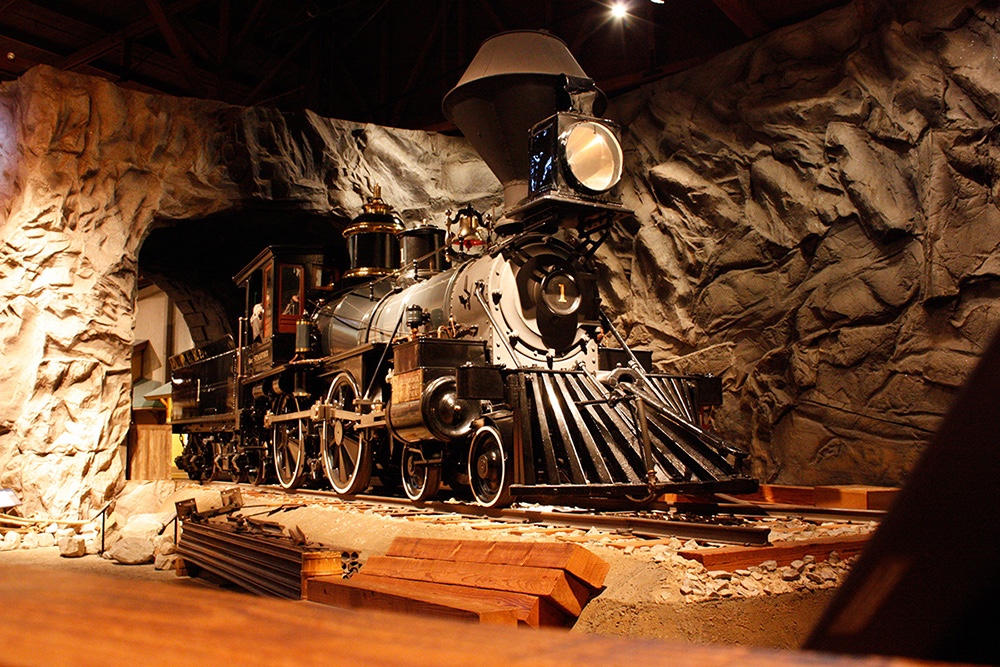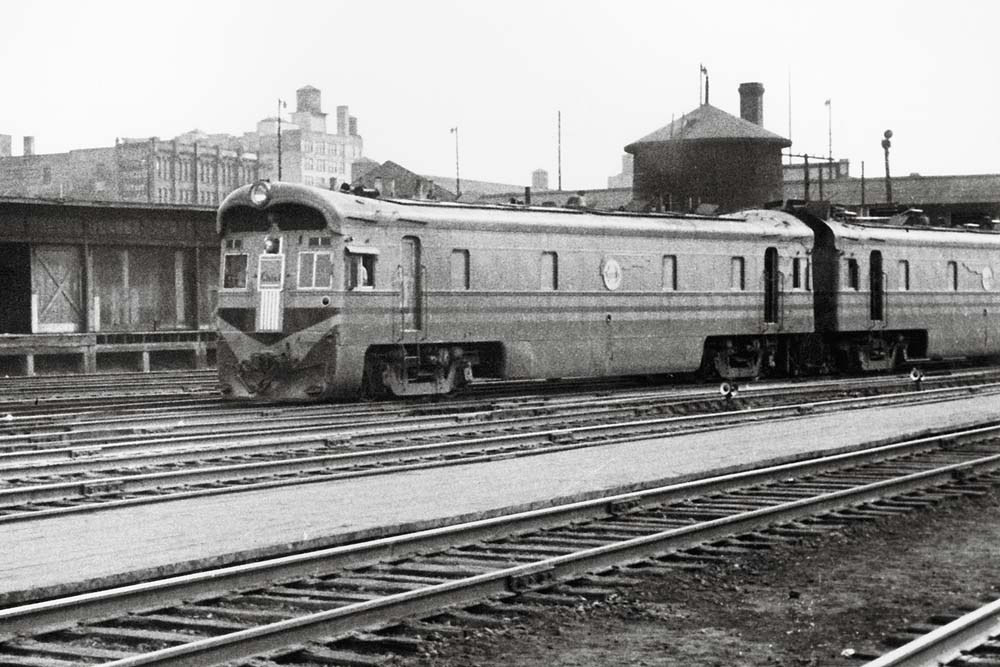Rock Island history is a mighty good history.
In 1847 the Rock Island & La Salle Rail Road was chartered to build between Rock Island, Ill., on the Mississippi River, and La Salle, where connections would be made with the Illinois & Michigan Canal to Chicago. Contractor Henry Farnam persuaded the organizers to extend the railroad all the way to Chicago to connect with other railroads. The charter was so amended, and the railroad was renamed the Chicago & Rock Island. Construction began in 1851. The first train ran from Chicago to Joliet, 40 miles, on Oct. 10, 1852. Its power was a 4-4-0 named Rocket.
The line was opened to Rock Island on Feb. 22, 1854, and the contractors turned the line over to the corporation in July of that year. By then the railroad had an agreement with the Northern Indiana Railroad (later part of the New York Central) for joint terminal facilities in Chicago, and a branch from Bureau, Ill., south to Peoria was nearly complete (it opened in November 1854).
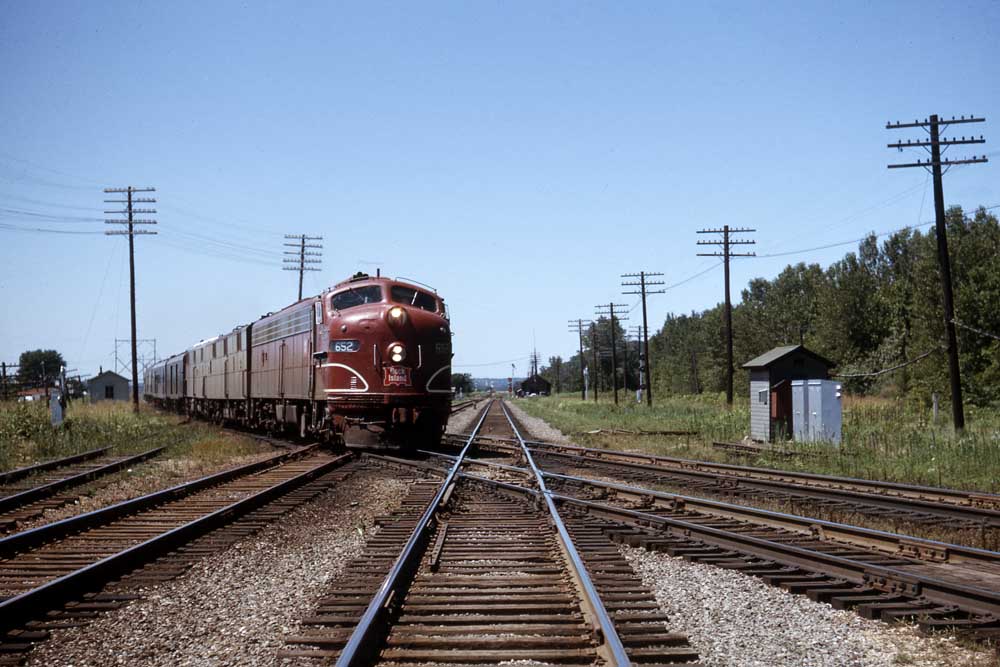
Beyond the Mississippi
The Mississippi & Missouri Railroad was chartered in Iowa to build a railroad from Davenport, across the Mississippi River from Rock Island, to Council Bluffs, with branches south through Muscatine and north through Cedar Rapids. Money to finance construction of the Mississippi & Missouri was hard to come by. Both Iowa City, then the state capital, and Muscatine wanted the railroad first. Iowa City offered a bonus if a train arrived by midnight, Dec. 31, 1855. Muscatine got its railroad first, on Nov. 20, 1855, but (if we are to believe contemporary accounts) a frozen locomotive was pushed over hastily laid and barely spiked rails into Iowa City as church bells rang in the New Year, securing the bonus and providing a perfect scenario for a multitude of grade-B novels and movies.
A bridge across the Mississippi was necessary to connect the Chicago & Rock Island and Mississippi & Missouri railroads. The Mississippi had not yet been spanned, and the immediate reaction to the proposed railroad bridge was that it would be a hazard to navigation. However, the bridge was built, and it was officially opened on April 21, 1856. On the evening of May 6 the steamboat Effie Afton, which usually plied the New Orleans-Louisville run, cleared the open draw span then veered aside, turned around, rammed one of the piers, and suddenly and suspiciously burst into flames. The case of the bridge soon became one of railroad advocates versus steamboat advocates. The latter felt that even a single bridge would set an unfortunate precedent and soon there would be bridges every 40 or 50 miles along the length of the river. The railroad’s case, argued by Abraham Lincoln, went one way and then the other in successive courts, but in 1866 the U. S. Supreme Court held for the railroad. Several other railroads immediately applied to bridge the Mississippi at other locations.
The Mississippi & Missouri, far behind its construction schedule, was sold to the newly incorporated Chicago, Rock Island & Pacific on July 9, 1866. On Aug. 20 that company consolidated with the Chicago & Rock Island to form a successor Chicago, Rock Island & Pacific Railroad. The line reached Des Moines a year later and arrived at Council Bluffs on May 11, 1869 — one day after the completion of the Union Pacific and Central Pacific railroads from Council Bluffs to the West Coast. The Rock Island was not the first railroad into Council Bluffs; the Cedar Rapids & Missouri (later part of the Chicago & North Western) had reached there more than two years earlier and established ties with the Union Pacific.
To Missouri, Kansas, and beyond
In the 1870s the road extended its Muscatine line southwest across Iowa and northwestern Missouri to Leavenworth, Kansas, and later negotiated trackage rights over the Hannibal & St. Joseph from Cameron, Mo., to Kansas City. Also during the 1870s the road acquired a couple of “firsts” — the first dining cars and Jesse James’s first train holdup.
The 1880s saw some corporate simplification, the acquisition of the Keokuk & Des Moines and the St. Joseph & Iowa, and control of the Burlington, Cedar Rapids & Northern, which had a line from Burlington, Iowa, through Cedar Rapids and Cedar Falls to Plymouth, near Mason City, with a branch through Iowa Falls and Estherville to Watertown, South Dakota. The BCR&N later acquired lines west out of Davenport and Clinton, Iowa, and lines to Decorah, Iowa, Worthington, Minn., and Sioux Falls, S.D.
On Dec. 5, 1883, the Rock Island made a tripartite agreement with Union Pacific and the Milwaukee Road for interchange of business at Omaha. The Chicago & North Western, which had been UP’s preferred connection, quickly became a party to the agreement, as did the Wabash, St. Louis & Pacific (a predecessor of the Wabash). The Burlington & Missouri River in Nebraska (part of the Burlington) protested the agreement.
Union Pacific suddenly found itself in financial difficulties, and Rock Island decided to build its own extensions west rather than rely on interchange traffic with UP. Two years later the Chicago, Kansas & Nebraska Railroad was chartered to build from St. Joseph and Atchison southwest across Kansas to Wichita, and another railroad of the same name was incorporated in Nebraska to build from the southeast tip of the state to Kearney. The two companies merged and were leased to the St. Joseph & Iowa Railroad, a subsidiary of the Rock Island. A charter was approved for the extension of the southwest line from Wichita to Galveston, Texas, and from Liberal, Kans., to El Paso. By the end of 1887 rails reached to Caldwell, on the southern border of Kansas, and in February 1888 they reached Liberal. A year later the Rock Island had built west across northern Kansas and Colorado to Colorado Springs. RI made arrangements to use Denver & Rio Grande track north to Denver and south to Pueblo; in 1889 RI began using Union Pacific tracks from Limon, Colo. to Denver.
Rock Island’s Chicago-Colorado route via St. Joseph was circuitous. To assemble a route through Omaha, RI constructed a line from Omaha to Lincoln and in 1890 traded the trackage rights from McPherson to Hutchinson, Kans. to Union Pacific for trackage rights on UP between Lincoln and Beatrice and use of UP’s Missouri River bridge between Council Bluffs and Omaha. RI began Chicago-Colorado service via Omaha on August 16, 1891, and later built its own line west of Lincoln. Also in 1891 Rock Island acquired the property of the Chicago, Kansas & Nebraska. Subsidiary Chicago, Rock Island & Texas reached Fort Worth in 1893.
The Reid-Moore era of Rock Island history
In 1901 control of the Rock Island was taken over by the Reid-Moore syndicate: Daniel G. Reed, William H. Moore, his brother James H. Moore, and William Leeds, men who had put together the National Biscuit, Diamond Match, and American Can companies. The road continued to burgeon. It acquired the Choctaw, Oklahoma & Gulf Railroad, a line from Memphis, Tenn., through Little Rock, Ark., and Oklahoma City to Elk City in western Oklahoma, and the 70-mile St. Louis, Kansas City & Colorado Railroad (which the Santa Fe at one point had considered acquiring for an entrance to St. Louis). Expansion continued:
- 1902 — lease of the Burlington, Cedar Rapids & Northern for 999 years, and extension of the southwestern line from Liberal to Santa Rosa, New Mexico, to connect with the El Paso & Northeastern, a Southern Pacific predecessor (the new track included the second-longest stretch of straight track in the U. S., nearly 72 miles between Guymon, Okla., and Dalhart, Tex.)
- 1903 — Chicago, Rock Island & Gulf completed a line between Fort Worth and Dallas
- 1904 — the Choctaw line was extended west to Amarillo, Tex., and the Kansas City-St. Louis line was opened
- 1905 — the road began assembling and constructing a line south from Little Rock to Eunice, Louisiana, with the intent of reaching New Orleans
- 1906 — RI acquired a half interest in the Trinity & Brazos Valley Railway (Dallas-
Houston-Galveston, later the Burlington-Rock Island Railroad) from the Colorado & Southern.
At the same time the controlling syndicate, which now included B. F. Yoakum, was busy acquiring control of the Chicago & Alton, the Chicago & Eastern Illinois, the Toledo, St. Louis & Western, and the St. Louis-San Francisco through holding companies and exchanges of stock. By 1909, though, the interest due on SLSF bonds far exceeded the dividends received on SLSF stock — none. B. F. Yoakum bought Rock Island’s Frisco stock at a considerable loss to the Rock Island.
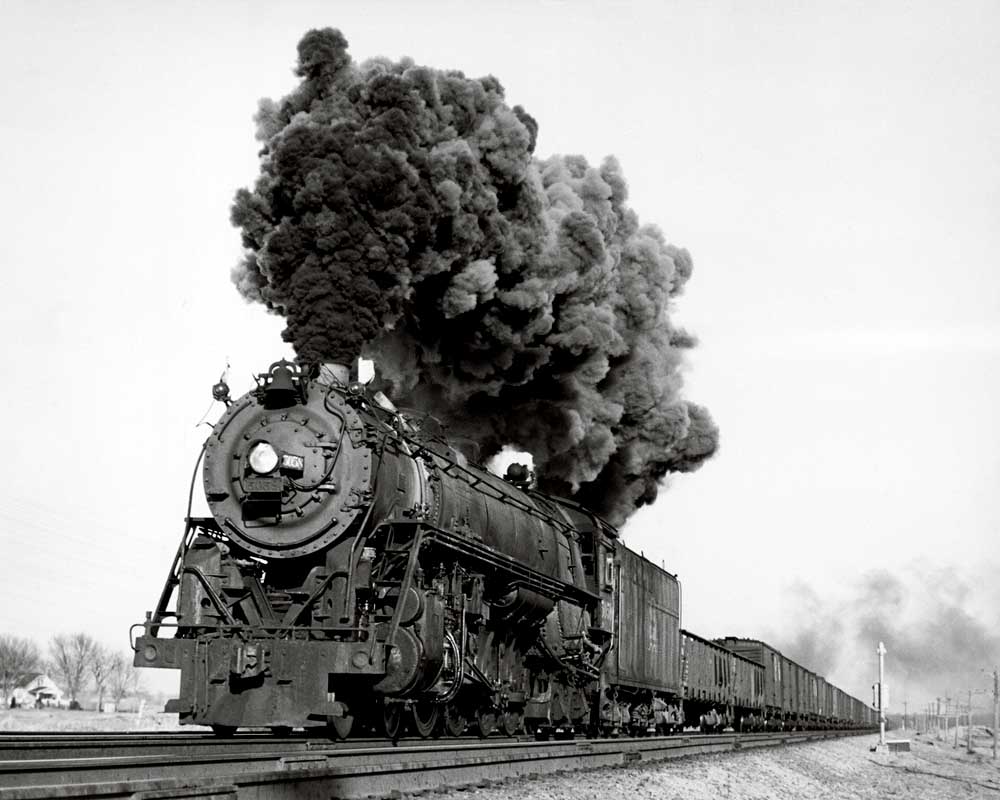
Financial difficulty
Rock Island created a Twin Cities-Kansas City route in 1913 by leasing the St. Paul & Kansas City Short Line Railroad and building a line between Allerton and Carlisle, Iowa, a few miles south of Des Moines. In 1914 red ink caused by debt interest appeared on Rock Island’s ledgers, and on April 20, 1915, the road entered receivership. On June 22, 1917, the road was out of receivership and back in the hands of its stockholders. Shortly afterward the United States Railroad Administration took over management for the duration of World War I.
New management took over in the 1920s and placed considerable emphasis on paying of stock dividends to the detriment of maintaining the property. Edward N. Brown, chairman of the board of the Frisco, began to buy Rock Island stock with the thought of using dividends to bolster the Frisco’s situation. Soon Brown was chairman of Rock Island’s executive committee. In 1927 Rock Island declared a stock dividend of 5%; in 1928, 6%; and in 1929, 7% — even though Rock Island’s annual interest on its debt was nearly $14 million. In 1930 Brown began to secretly acquire Frisco stock for the Rock Island. Revenues dropped as the depression deepened. Then Rock Island’s territory was struck with wheat crop failures and dust storms. The Rock Island declared bankruptcy on June 7, 1933.
Edward M. Durham, vice-president of Missouri Pacific, took over as chief executive officer in December 1935. He brought in John D. Farrington, general manager of the Fort Worth & Denver, as operating officer in May 1936. Farrington started a scrap drive to finance a rail relay program and purchased ten diesel switchers and six diesel-powered Rocket streamliners. His program included line relocations between Davenport and Kansas City and a new bridge over the Cimarron River just east of Liberal, Kan. The road turned a profit in 1941. Durham retired in July 1942, and Farrington took over as CEO.
The Chicago, Rock Island & Pacific Railroad emerged from a long and acrimonious reorganization on Jan.1, 1948. Farrington was still leading the company and pursuing a program of dieselization, line improvement, and industrial development. Rock Island rolled on through the 1950s and into the 1960s doing decently although surrounded by stronger railroads. Its freight traffic was largely agricultural. Its passenger trains for the most part would take you anywhere the Burlington or the Santa Fe could, but not as quickly nor with quite as much style.
The fight over the Rock Island
In 1964 Ben Heineman, chairman of the Chicago & North Western, proposed merging the C&NW, the Rock Island, and the Milwaukee Road into an Upper Midwest system and selling the lines south of Kansas City to Santa Fe. Union Pacific made a counterproposal: merger, which would put the UP into Chicago. That year, 1964, was Rock Island’s last year of profitability.
The proposal turned into the longest, most complicated merger case ever handled by the Interstate Commerce Commission. The other railroads west of Chicago protested one aspect or another of the merger, petitioned for inclusion, or asked for a piece of the Rock Island. In 1970 the Milwaukee Road, which had fallen on hard times, entered the case, asking for inclusion in Union Pacific or Southern Pacific. In 1973 the ICC proposed restructuring the railroads of the West into four systems: Union Pacific, Southern Pacific, Burlington Northern, and Santa Fe. The railroads involved in the merger case other than the two principals petitioned the ICC to dismiss the case and start over.
The ICC finally approved the merger on Nov. 8, 1974, with several conditions: Southern Pacific would be allowed to purchase the Kansas City-Tucumcari line (that had been part of the UP merger proposal from the beginning); the Omaha-Colorado Springs line would be sold to the Denver & Rio Grande Western; and Santa Fe would be permitted to buy the Choctaw Route (Memphis-Amarillo) only if it would absorb the bankrupt and decrepit Missouri-Kansas-Texas. Union Pacific said it would have to re-evaluate the merger, since the Rock Island of 1974 wasn’t the Rock Island of 1964. Rock Island filed for bankruptcy on March 17, 1975, and on Aug.4 of that year UP withdrew its merger offer. The ICC dismissed the case on July 10, 1976.
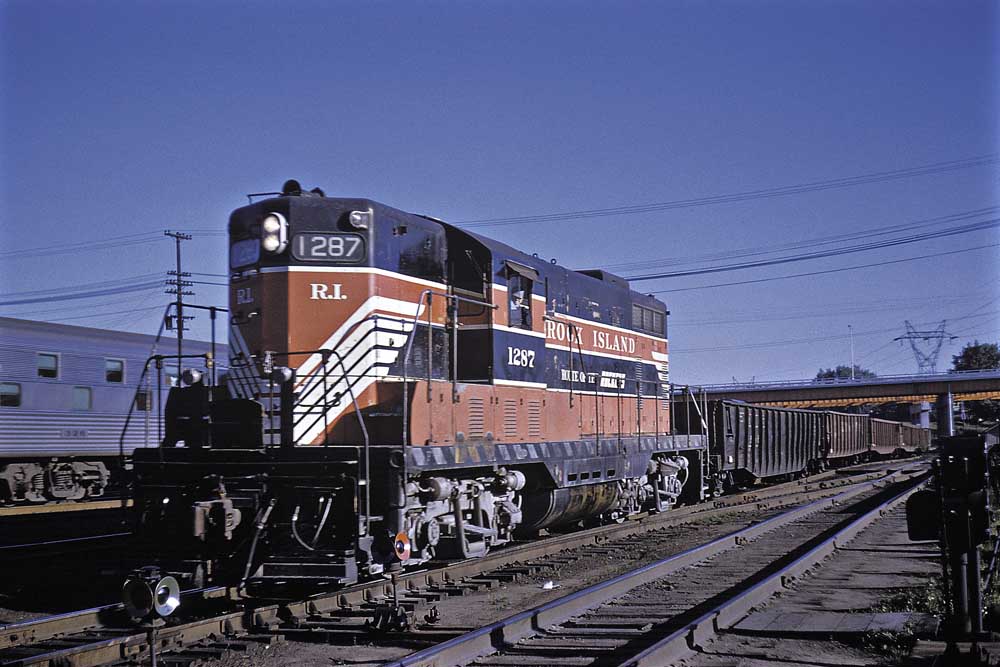
Slow death of Rock Island history
By then the Rock Island was in terrible shape. A new management headed by John W. Ingram did its best, introducing a new image of sky-blue and white and appointing John W. Barriger III, then 76 years old, as Senior Traveling Freight Agent (Barriger’s own title) and consultant.
Rock Island’s clerks walked off their jobs on Aug. 28, 1979, over a pay dispute, and United Transportation Union members followed the next day. President Jimmy Carter issued an order Sept. 20 creating an emergency board to settle the dispute. The UTU members then returned to their jobs, but members of the Brotherhood of Railway and Airline Clerks stayed off. On Sept. 26 the Kansas City Terminal was ordered by the ICC to operate the railroad. KCT’s owners plus Denver & Rio Grande Western and Southern Pacific began operating the Rock Island. On March 2, 1980, the ICC refused to extend its directed service order, and the Rock Island ceased operation March 31, 1980.
The railroad industry had never before seen an abandonment of the magnitude of Rock Island. Other railroads had been abandoned in their entirety, but they were roads like the New York, Ontario & Western (541 miles, 1957; it had always been sickly and shouldn’t have been built), Fort Smith & Western (250 miles, 1939; it didn’t go anywhere and shouldn’t have been built), and the Colorado Midland (338 miles, 1918; it had steep grades and shouldn’t have been built — and 1918 was ancient history anyway).
The 7,000-mile Rock Island connected big cities like Chicago, Denver, Minneapolis, Houston, and Kansas City. It had no major operating handicaps, like mountains. It had long routes, so it wasn’t another Reading or Central of New Jersey. Industry reaction to the abandonment ranged from “Someone has to take it over and run it” to “Can I have the Kansas City-Minneapolis line?”
When the dust settled it turned out that what was abandoned was the operating company and financial structure, not the physical plant. Rock Island’s sky-blue freight cars showed up with reporting marks like C&NW and BM underneath the slogan “The Rock,” and the fixed plant of the railroad was parceled out to other railroads, including Southern Pacific, Cotton Belt, Burlington Northern, Chessie System, and Missouri Pacific. Other lines became regional railroads, including Iowa Interstate and Kyle.







